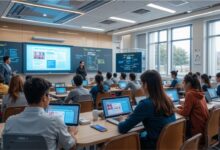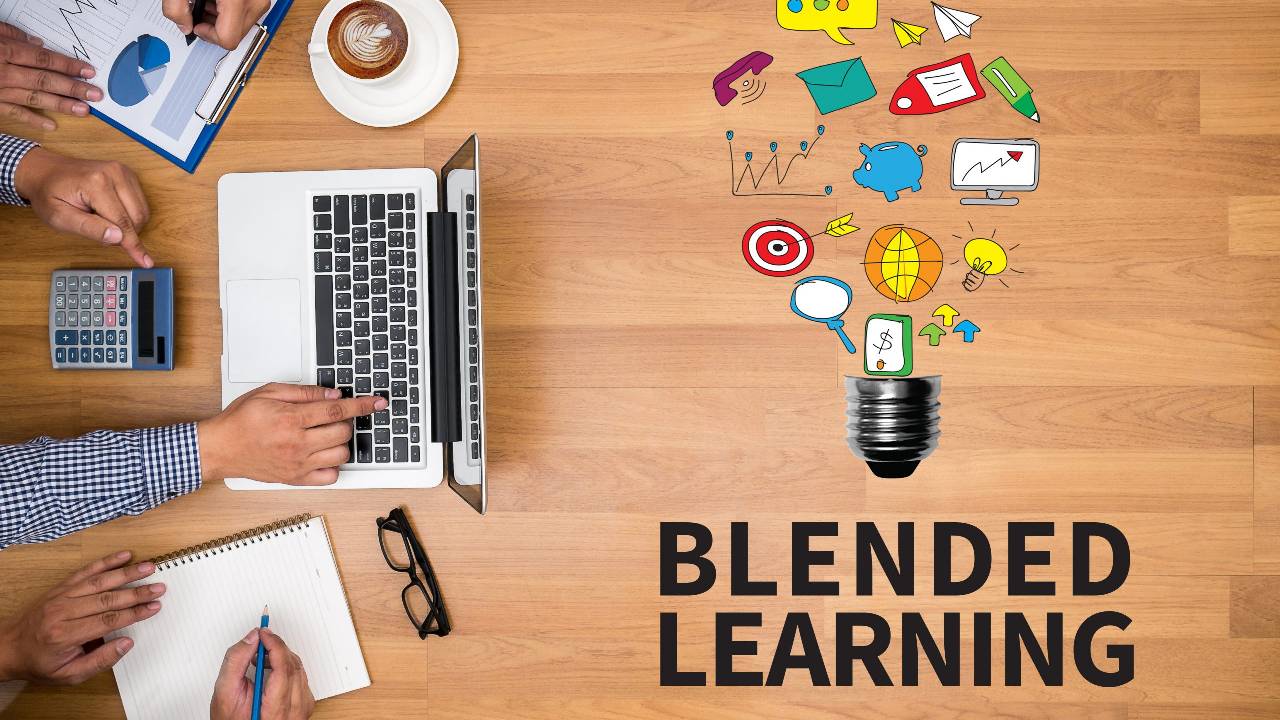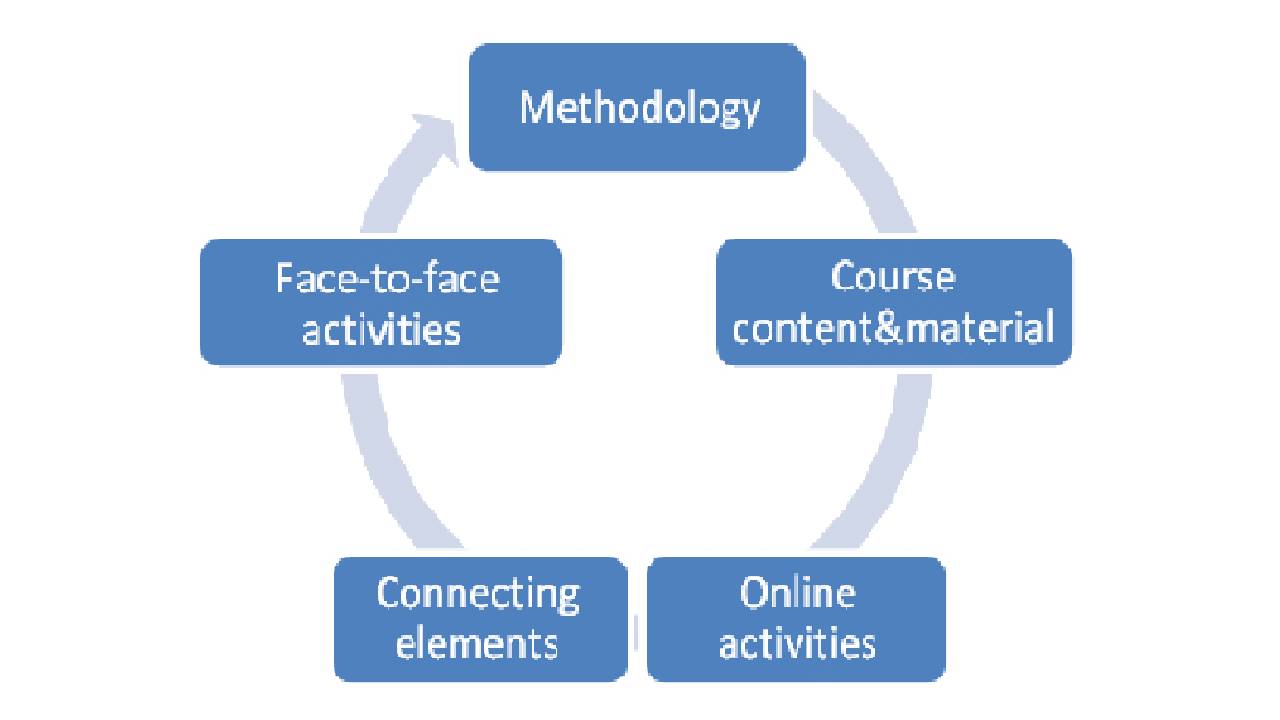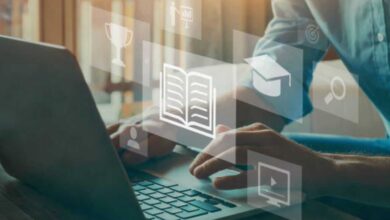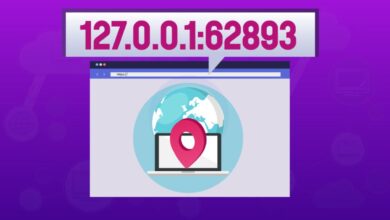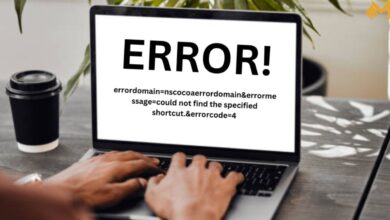Blended Learning Defined and The Benefits of Using it
Navigating Models, Pedagogy, and Tools for Effective Blended Learning

In the dynamic landscape of education, the term “blended learning” has emerged as a transformative approach that seamlessly integrates traditional and digital learning methods.
Blended learning, often referred to as a hybrid learning model, signifies the intentional combination of face-to-face instruction with online learning elements, creating a rich and adaptable educational experience.
Blended learning evolves by integrating traditional teaching with innovative technology, shaping dynamic educational environments that harmonize diverse methods seamlessly.
Integrated for varied learning preferences, it provides a flexible, personalized educational journey, extending beyond traditional classrooms for enhanced adaptability.
The significance of mixed learning in training couldn’t possibly be more significant, as it not only addresses the difficulties presented by various learning styles but additionally prepares understudies for the requests of a mechanically determined world.
This article dives into the complex meaning of mixed learning, investigates the development of mixed learning conditions, and reveals insight into the significant advantages it brings to the instructive domain. Unraveling blended learning intricacies, from flexible formats to digital classrooms, emphasizes its pivotal role in shaping the future of education.
Understanding Blended Learning
In the ever-evolving landscape of education, the concept of blended learning has emerged as a pivotal strategy, seamlessly integrating traditional and digital pedagogies.
Blended learning, blending face-to-face and online instruction, embodies a dynamic education approach catering to diverse learner needs harmoniously.
This segment delves into essential blended learning concepts, clarifying foundational principles and analyzing models balancing traditional and technology-enhanced learning approaches.
Key Concepts of Blended Learning
At its core, blended learning is rooted in the integration of online and offline learning components, creating an educational experience that transcends the boundaries of traditional classrooms. The key concepts encompass flexibility, personalized learning, and a seamless fusion of synchronous and asynchronous learning.
By leveraging digital tools within the traditional learning environment, educators aim to create an engaging and adaptable educational ecosystem, where students actively participate, collaborate, and take charge of their learning journey.
Types of Blended Learning Models
In the dynamic landscape of education, the exploration of various blended learning models becomes imperative to understand the versatility this pedagogical approach offers.
Blended learning, with its commitment to integrating both traditional and digital instructional methods, encompasses diverse models that cater to the unique needs and preferences of learners.
This section delves into the intricate tapestry of blended learning models, each designed with a specific emphasis on achieving a harmonious balance between in-person and online learning components.
Examining these models provides insight into the nuanced approaches educators adopt for engaging, flexible, and personalized 21st-century learning experiences for students.
From the strategic fusion of traditional and digital elements in Hybrid Learning Models to the varied instructional approaches of Mixed-Mode Instruction and the adaptability of Flexible Learning Formats, this exploration aims to illuminate the spectrum of possibilities within the realm of blended learning.
Hybrid Learning Models:
Hybrid learning models represent a strategic amalgamation of in-person and online learning experiences. In this model, traditional classroom instruction is complemented and enhanced by digital resources and tools.
This approach offers students the benefits of both face-to-face interactions with instructors and the flexibility to engage with course materials digitally.
Hybrid learning environments leverage technology to create a dynamic and interactive space that caters to varied learning preferences.
Mixed-Mode Instruction:
The mixed-mode instruction approach involves a diverse integration of teaching methods, combining traditional lectures with online components.
Educators utilizing this model design courses that incorporate in-person discussions, collaborative online activities, and multimedia resources. This versatility allows for a tailored approach to learning, accommodating different learning styles and fostering a holistic understanding of the subject matter.
Flexible Learning Formats:
Flexibility is a hallmark of blended learning, and flexible learning formats epitomize this adaptability. Courses designed with flexible learning formats seamlessly integrate online and offline elements, allowing students to engage with course content at their own pace.
This model accommodates diverse schedules and preferences, fostering a student-centric environment that promotes autonomy and self-directed learning.
III. Components of Blended Learning
In the steadily developing scene of schooling, the idea of mixed learning remains a demonstration of development and flexibility. As we dig into the center parts of mixed learning, it becomes obvious that this instructive methodology is a nuanced combination of customary and computerized components, establishing a dynamic and flexible learning climate.
This section unravels the essential components that constitute the intricate tapestry of blended learning, showcasing the deliberate integration of online and offline learning, synchronous and asynchronous instruction, as well as the application of integrated and technology-enhanced approaches.
By examining these components, we gain a comprehensive understanding of how educators strategically combine various elements to create an engaging and effective educational experience for students in today’s diverse and technology-driven world.
Online and Offline Learning
Blended learning’s strength lies in its ability to seamlessly integrate both online and offline learning components. Students engage with course materials through digital platforms while benefiting from face-to-face interactions with instructors.
This dual approach offers a well-rounded educational experience, combining the flexibility and accessibility of online resources with the personal connection and guidance provided in traditional classroom settings.
Synchronous and Asynchronous Learning
The incorporation of both synchronous and asynchronous learning methods further enhances the adaptability of blended learning. Synchronous learning involves real-time interactions, such as live online lectures or discussions, fostering immediate engagement.
Conversely, asynchronous learning allows students to access course materials at their own pace, promoting flexibility and accommodating diverse schedules. The balance of these two approaches caters to different learning preferences, creating a dynamic and inclusive learning environment.
Integrated Learning Approaches
Blended learning thrives on integrated learning approaches that seamlessly combine various instructional methods. This might involve combining traditional lectures with online discussions, collaborative projects, or multimedia resources.
The integration of diverse learning approaches ensures a holistic educational experience, addressing the different learning styles and preferences within a diverse student population.
Technology-Enhanced Learning
At the heart of blended learning is the concept of technology-enhanced learning, where digital tools and resources play a pivotal role in enriching the educational experience.
From interactive multimedia presentations to online assessments, technology enhances engagement, promotes interactivity, and provides valuable data for personalized learning.
Embracing technology ensures students acquire subject knowledge and vital digital literacy skills essential for success in the modern world.
Tools and Platforms for Blended Learning
As we navigate the realms of education in the 21st century, integrating technology plays a pivotal role in shaping the landscape of blended learning. In this section, we explore the essential tools and platforms that facilitate the seamless fusion of traditional and digital instructional methods within the context of blended learning.
From dedicated blended learning platforms to innovative digital classroom solutions and the indispensable role of Learning Management Systems (LMS), educators harness these technological tools to create dynamic, engaging, and effective learning experiences for students in diverse and ever-evolving academic environments.
Blended Learning Platforms
Blended learning platforms stand as the technological backbone of modern education, providing a cohesive space where traditional and digital elements converge seamlessly.
These platforms offer educators the tools to design, deliver, and manage blended learning courses effectively. With features that enable content delivery, interactive assessments, and collaborative forums, these platforms empower educators to craft engaging learning experiences that transcend the constraints of physical classrooms.
Digital Classroom Solutions
The advent of digital classroom solutions has revolutionized the traditional teaching paradigm, offering educators and students a dynamic and interactive virtual environment. These solutions encompass a spectrum of tools, including multimedia presentations, virtual whiteboards, and collaborative online spaces.
Digital classroom solutions not only facilitate the delivery of content but also promote student engagement through interactive activities, fostering a sense of connection and participation even in the digital realm.
Learning Management Systems (LMS)
At the heart of effective blended learning implementation lies the Learning Management System (LMS). This comprehensive tool serves as a centralized hub for organizing, delivering, and tracking educational content.
LMS platforms enable educators to create structured courses, manage assignments, and track student progress. At the same time, understudies benefit from an easy-to-understand interface that gives simple admittance to course materials, works with correspondence with teachers and companions, and offers instruments for evaluation and input.
Fundamentally, the incorporation of these instruments and stages epitomizes the marriage of customary showing techniques with imaginative innovations, cultivating an all-encompassing and versatile way to deal with instruction.
Blended learning, supported by these technological foundations, transcends the boundaries of physical classrooms, opening up new avenues for collaborative learning and ensuring that education remains responsive to the needs of the digital age.
Benefits of Blended Learning
As education embraces the digital era, the implementation of blended learning emerges as a transformative force, offering a myriad of benefits that cater to the diverse needs of learners.
This section explores the advantages that blended learning brings to the forefront, emphasizing its impact on improved learning outcomes, heightened student engagement, flexibility for diverse learning styles, and the facilitation of personalized learning experiences.
The holistic integration of traditional and digital instructional methods within the blended learning framework proves to be a catalyst for educational enhancement, ensuring that students not only acquire knowledge but also develop essential skills crucial for success in the dynamic and technology-driven world.
Improved Learning Outcomes
Blended learning’s potency lies in its ability to significantly improve learning outcomes. By joining the qualities of customary eye-to-eye guidance with the intuitive and versatile components of Internet learning, understudies benefit from a balanced instructive encounter.
The mix of media assets, certifiable applications, and cooperative internet-based exercises establishes a thorough learning climate that cultivates a more profound comprehension of the topic. Thus, understudies are better prepared to hold data, apply ideas, and exhibit a more significant level of capability in their examinations.
Enhanced Student Engagement
Blended learning actively promotes student engagement by leveraging the interactive and collaborative features of digital tools. Whether through online discussions, multimedia presentations, or virtual group projects, students are encouraged to actively participate in the learning process.
The incorporation of technology enhances the overall appeal of educational content, capturing students’ interest and fostering a sense of curiosity. The result is a more engaged and motivated student body, eager to explore and contribute to their educational journey.
Flexibility for Diverse Learning Styles
One of the hallmark benefits of blended learning is its inherent flexibility, accommodating a spectrum of diverse learning styles. Recognizing that each student possesses unique strengths and preferences, blended learning allows for a personalized approach to education.
Whether a student thrives in a traditional classroom setting or prefers the autonomy of online learning, the blended model caters to both, ensuring that no learner is left behind. This adaptability is particularly crucial in creating an inclusive educational environment that resonates with the individual needs of a diverse student population.
Personalized Learning Experiences
Blended learning paves the way for personalized learning experiences, tailoring educational content to the specific needs and pace of each student. The integration of technology enables the tracking of individual progress, allowing educators to provide targeted support and interventions where necessary.
Through adaptive learning platforms and customized assignments, students can navigate their educational journey at their own pace, reinforcing their strengths and addressing areas that require additional attention.
This personalized approach not only enhances academic performance but also nurtures a sense of responsibility and ownership in students regarding their learning.
In essence, the benefits of blended learning extend beyond traditional educational boundaries, fostering an environment where students can thrive academically and develop essential skills for the future.
This section underscores how the integration of diverse instructional methods within the blended learning framework contributes to a holistic and student-centered approach to education.
Student Role in Blended Learning
In the realm of blended learning, students take on an active and participatory role, becoming integral architects of their educational journey. Blended learning environments place a premium on fostering not just academic growth, but also the development of crucial skills that transcend the traditional boundaries of education.
This section delves into the multifaceted roles that students play in the blended learning landscape, exploring their active participation, cultivation of self-regulated learning practices, and honing collaboration and communication skills.
By embracing these roles, students not only adapt to the dynamic nature of blended learning but also cultivate attributes that are invaluable in the contemporary digital age.
Active Participation
Blended learning propels students into the forefront of their education, demanding active and engaged participation. Through both eye-to-eye associations and online stages, understudies are urged to add to conversations, get clarification on pressing issues, and effectively look for understanding.
The different parts of mixed learning, from conventional homeroom conversations to online gatherings and cooperative tasks, give roads to understudies to offer their viewpoints, share bits of knowledge, and effectively shape growth opportunities.
This active participation not only deepens their understanding of the subject matter but also cultivates a sense of responsibility for their learning journey.
Self-Regulated Learning
Blended learning necessitates a shift towards self-regulated learning, where students assume greater responsibility for managing their time, setting goals, and monitoring their progress.
In an environment that seamlessly integrates online and offline resources, students must develop effective strategies to navigate the diverse learning materials.
This newfound autonomy instills a sense of ownership in students, encouraging them to become proactive learners who can adapt to various learning styles and take charge of their educational paths.
Self-regulated learning becomes a cornerstone skill, empowering students not just academically but also in their broader personal and professional pursuits.
Collaboration and Communication Skills
Blended learning thrives on the cultivation of collaboration and communication skills, essential attributes in the modern interconnected world.
Through online discussions, group projects, and interactive activities, students learn to collaborate effectively with peers, leveraging diverse perspectives to solve problems and generate creative solutions.
The blend of synchronous and asynchronous communication modes hones their ability to express ideas clearly and thoughtfully, both in face-to-face interactions and virtual spaces.
These skills extend beyond the academic realm, preparing students for success in a workforce where collaboration and effective communication are increasingly valued.
In essence, the student’s role in blended learning goes beyond the passive reception of information. Instead, students become active participants, self-regulated learners, and adept collaborators, preparing them not only for academic success but also for the multifaceted challenges of the digital age.
This segment highlights the groundbreaking effect of mixed learning on understudies, engaging them to explore the intricacies of the cutting-edge instructive scene with certainty and skill.
Advantages and Disadvantages of Blended Learning
In the powerful scene of schooling, the reception of mixed learning delivers a range of benefits and hindrances that shape the growth opportunity for the two teachers and understudies.
This segment means to analyze the complexities of mixed picking up, looking at its benefits concerning adaptability, availability, and improved commitment, while likewise diving into the difficulties it presents, like specialized obstacles and the potential for disparity.
Understanding the nuanced interplay between these advantages and disadvantages is crucial in crafting effective blended learning environments that harness the benefits while addressing the associated challenges, ensuring a balanced and impactful educational experience.
Advantages
- Flexibility: One of the foremost advantages of blended learning lies in its inherent flexibility. By seamlessly integrating online and offline learning components, students gain the autonomy to engage with educational materials at their own pace and convenience. This adaptability caters to diverse learning styles and accommodates varying schedules, fostering a student-centric approach that empowers learners to take control of their educational journey.
- Accessibility: Blended learning extends the reach of education beyond the confines of traditional classrooms. Through the utilization of online resources, students can access learning materials from anywhere, breaking down geographical barriers and providing an inclusive educational experience. This enhanced accessibility ensures that education becomes more equitable, reaching learners who may face geographical, physical, or other constraints.
- Enhanced Engagement: The combination of traditional and digital instructional methods within blended learning environments enhances student engagement. The integration of multimedia resources, interactive activities, and collaborative online platforms captivates students’ interest, fostering a more dynamic and participatory learning experience. Enhanced engagement not only deepens understanding but also contributes to a more positive and motivating educational atmosphere.
Disadvantages
- Technical Challenges: While blended learning opens doors to a wealth of online resources, it also introduces technical challenges that may impede the learning process. Issues such as unreliable internet connections, software glitches, or a lack of access to necessary devices can disrupt the flow of education. Mitigating these challenges requires ongoing technical support and resources to ensure a seamless and accessible learning experience for all students.
- Potential for Inequality: Blended learning, if not carefully implemented, has the potential to exacerbate existing inequalities. Students with limited access to technology or a stable internet connection may face barriers to fully participating in the online components of blended courses. Addressing this potential for inequality requires proactive measures, such as providing access to necessary technology and creating alternative pathways for students facing resource constraints.
In conclusion, the advantages and disadvantages of blended learning represent a delicate balance that educators must navigate to create effective and inclusive learning environments. By leveraging the benefits of flexibility, accessibility, and enhanced engagement while proactively addressing technical challenges and potential inequalities, educators can maximize the positive impact of blended learning on student learning outcomes.
Exploring Blended Learning Models
Embarking on a nuanced exploration of blended learning models unveils a rich tapestry of instructional methodologies that blend traditional and digital elements.
This section delves into the intricacies of the six prominent models of blended learning, shedding light on the diverse approaches educators employ to enhance the learning experience.
From understanding the pedagogical principles that underpin blended learning to crafting effective blended lesson plans and courses, this exploration aims to provide educators with insights into the multifaceted world of blended learning.
By unraveling these models, we seek to empower educators to navigate the complexities of blended learning and leverage its full potential in creating dynamic and effective educational environments.
The Six Models of Blended Learning
The landscape of blended learning is characterized by six distinctive models, each offering a unique blend of traditional and digital instructional methods.
- The Rotation Model involves students rotating between face-to-face and online learning activities, providing a balanced approach.
- The Flex Model allows for a flexible schedule, granting students the autonomy to determine when and where they engage with online content.
- The Enriched Virtual Model predominantly takes place online with occasional face-to-face interactions, offering a more independent learning experience.
- The À La Carte Model allows students to take individual online courses in addition to traditional classes, offering personalized pathways.
- The Station Rotation Model involves students rotating between various learning stations, combining online and face-to-face activities.
- Lastly, the Lab Rotation Model integrates online learning with a dedicated computer lab, providing students with hands-on digital experiences.
Understanding these models empowers educators to tailor their approach to meet the unique needs of their students and learning objectives.
Understanding Pedagogy in Blended Learning
At the heart of effective blended learning lies a profound understanding of pedagogical principles. Blended learning pedagogy emphasizes a student-centered approach, fostering engagement, critical thinking, and collaborative skills.
Educators strategically combine traditional and digital instructional methods, ensuring a seamless integration that enhances the overall learning experience.
Pedagogy in blended learning involves designing activities that promote active participation, providing timely feedback, and adapting instruction to cater to diverse learning styles.
By embracing pedagogical best practices, educators can create an enriching and adaptive learning environment that maximizes the benefits of blended learning.
Blended Lesson Plans and Courses
Crafting effective blended lesson plans and courses is a crucial aspect of successful blended learning implementation. Lesson plans should seamlessly integrate online and offline activities, incorporating multimedia resources, interactive discussions, and hands-on projects.
The design should consider the varied learning modalities and provide clear objectives, assessments, and opportunities for student collaboration. Additionally, course structure should balance face-to-face and online components, ensuring a cohesive and engaging learning journey.
By thoughtfully constructing lesson plans and courses, educators can optimize the advantages of blended learning, promoting student success and fostering a positive and adaptive educational experience.
Tools and Techniques for Blended Learning
Navigating the intricate landscape of blended learning necessitates a thoughtful integration of tools and techniques that synergize traditional and digital instructional methods.
In this section, we delve into the fundamental components that form the backbone of effective blended learning. From the pivotal role of Learning Management Systems (LMS) in organizing and delivering content to the seamless integration of technology across varied learning environments, and finally, the critical process of assessing the effectiveness of blended learning, educators and institutions are provided with insights and strategies to harness the full potential of this dynamic educational approach.
By understanding and mastering these tools and techniques, educators can create engaging, adaptive, and successful blended learning experiences for their students.
Learning Management Systems (LMS)
Central to the success of blended learning is the incorporation of robust Learning Management Systems (LMS). These platforms serve as the digital hub, facilitating the organization, delivery, and tracking of educational content.
Through an LMS, educators can upload resources, create assignments, track student progress, and provide a centralized space for communication and collaboration. This seamless integration of online tools streamlines the learning process, offering students and educators a user-friendly interface to navigate the blended learning landscape.
The effective utilization of an LMS enhances accessibility, promotes engagement, and ensures the efficient management of blended learning courses.
Technology Integration
The effective integration of technology is paramount in creating a cohesive blended learning environment. Technology-enhanced learning tools, including multimedia presentations, interactive simulations, and virtual collaboration platforms, amplify the educational experience.
These tools bridge the gap between online and offline learning, providing a dynamic and interactive medium for content delivery. The key lies in aligning technology with learning objectives, ensuring that it enhances rather than distracts from the educational process.
Thoughtful technology integration not only captivates student interest but also cultivates digital literacy skills, essential for success in the modern world.
Assessing Blended Learning Effectiveness
Assessing the effectiveness of blended learning involves a multifaceted approach that goes beyond traditional evaluation methods. Educators must consider both qualitative and quantitative measures, including student performance, engagement levels, and feedback.
Regular assessments, formative evaluations, and feedback mechanisms provide valuable insights into the strengths and areas for improvement within the blended learning framework.
Additionally, leveraging data analytics from Learning Management Systems helps track student progress and tailor instructional strategies accordingly.
By continuously assessing the effectiveness of blended learning, educators can refine their approach, ensuring that it remains adaptive, engaging, and aligned with educational objectives.
Challenges and Solutions
In the dynamic landscape of education, where traditional methodologies intersect with the digital realm, blended learning presents an innovative and transformative approach.
However, as with any paradigm shift, challenges inevitably arise. This section navigates the complexities of blended learning, addressing common obstacles and offering viable solutions.
From overcoming barriers that hinder seamless integration to delineating the crucial role of teachers in implementation, and emphasizing the importance of clear structural frameworks, educators are equipped with insights to navigate challenges and harness the full potential of blended learning.
By illuminating the path through these challenges, we strive to fortify the foundation of blended learning, ensuring its efficacy in shaping the future of education.
Overcoming Barriers to Blended Learning
The adoption of blended learning is not without its challenges. Access to technology, varying digital literacy levels among students, and resistance to change are common barriers that educators encounter. To overcome these obstacles, a proactive approach is essential.
Providing access to necessary technology resources, offering targeted digital literacy training, and fostering a culture of adaptability can address these challenges.
Additionally, open communication and collaboration between educators, students, and parents contribute to a supportive environment that facilitates the seamless integration of blended learning.
Teacher’s Role in Implementing Blended Learning
The success of blended learning is intricately tied to the role of educators in its implementation. Teachers serve as guides, facilitators, and motivators, navigating students through the blended learning landscape.
To enhance their effectiveness, educators should undergo professional development to acquire digital literacy skills, instructional design techniques, and strategies for managing the diverse needs of a blended learning classroom.
Cultivating a collaborative culture among educators allows for the sharing of best practices and the collective development of innovative approaches to blended learning, ensuring that the teacher’s role is central to the success of this educational model.
Importance of Clear Structure in Blended Learning
A clear structure is the linchpin of effective blended learning. A well-defined framework ensures that students, educators, and stakeholders understand the expectations and processes involved. Structuring content delivery, assessments, and communication channels creates a cohesive learning experience.
This clarity is particularly crucial in blended learning environments, where the combination of online and offline elements requires careful orchestration.
Implementing a consistent and transparent structure not only fosters a sense of stability but also empowers students to navigate the blended learning landscape with confidence, optimizing their educational journey.
Frequently Asked Questions (FAQs)
What is the Difference Between Blended Learning and Normal Learning?
The essential contrast between mixed learning and typical learning, frequently alluded to as conventional learning, lies in educational conveyance techniques. In ordinary learning, training regularly happens completely in a conventional homeroom setting, with eye-to-eye collaborations among educators and understudies.
Mixed learning, then again, consolidates customary homeroom techniques with online components, taking into consideration a more adaptable and versatile opportunity for growth.
It incorporates innovation, media assets, and online exercises to supplement eye-to-eye guidance, offering a customized and dynamic methodology that goes past the limits of a conventional homeroom.
How Do You Structure Blended Learning?
Organizing mixed learning includes cautiously planning the mix of face-to-face and online parts to make a firm and successful opportunity for growth.
A typical methodology is to decide the proportion of up close and personal and online guidance in view of the learning targets and the requirements of understudies.
Various models, such as the Rotation Model, Flex Model, and Enriched Virtual Model, offer different structures for blending these elements.
Moreover, a Learning The board Framework (LMS) is frequently utilized to sort out happy, tasks, and correspondence. The key is to make a reasonable and clear-cut structure that consistently coordinates the two modalities, guaranteeing a decent and drawing-in learning climate.
What is Blended Learning Also Called?
Blended learning is also known by several other names, with interchangeable terms often used in the educational landscape. Some common alternative names for blended learning include hybrid learning, mixed-mode instruction, and integrated learning approaches.
These terms highlight the integration of both traditional and digital instructional methods within the learning process. Blended learning’s diversity in terminology coexists with its core essence: fusing face-to-face and online components to enhance the educational journey.
What is the Blended Method of Teaching?
The blended method of teaching is a pedagogical approach that seamlessly integrates traditional face-to-face instruction with digital learning components. This method harnesses the strengths of both in-person and online teaching, creating a dynamic and adaptive learning experience.
In a blended learning environment, students engage with educational content through a combination of traditional classroom interactions and online resources. This hybrid approach aims to leverage the benefits of both modalities, fostering a more personalized, flexible, and interactive educational experience.
What are the Four Elements of Blended Learning?
The effectiveness of blended learning hinges on the incorporation of four essential elements.
- Firstly, face-to-face instruction in a traditional classroom setting remains a foundational component.
- Secondly, online learning components, including multimedia resources, interactive activities, and virtual discussions, enhance the learning experience.
- The third element involves student autonomy, allowing learners to navigate through content at their own pace.
- Finally, ongoing assessment and feedback mechanisms form the fourth element, providing educators with insights into student progress and enabling targeted support.
These four elements work synergistically to create a holistic and adaptive blended learning environment.
What are the Different Types of Blending?
Blended learning provides diverse possibilities, enabling educators to customize their approach for specific learning goals and individual student requirements.
The most common types include the Rotation Model, where students rotate between traditional and online learning activities; the Flex Model, which provides students with a flexible schedule to determine when and where they engage with online content; the Enriched Virtual Model, involving most of the learning taking place online with occasional face-to-face interactions; and the À La Carte Model, where students take individual online courses in addition to their traditional classes.
These diverse blending models provide educators with flexibility in designing instructional strategies that align with their educational goals.
Conclusion
In delving into the intricacies of blended learning, we’ve uncovered a dynamic educational paradigm that seamlessly intertwines traditional methods with innovative digital approaches. Blended learning emerges as a catalyst for educational transformation, encapsulating the essence of adaptability, engagement, and personalized learning.
In recapitulating key points, we recognize the pivotal role of hybrid learning models, the integration of online and offline components, and the diverse advantages that come with this harmonious blend.
Looking forward, the future of blended learning in education appears promising, with its ability to meet the evolving needs of the digital age. As we navigate this educational frontier, fostering collaboration, addressing challenges, and refining our strategies become paramount.
Blended learning, with its flexible formats and technology-enhanced solutions, stands at the forefront of shaping a more inclusive and effective educational landscape.
In closing, the success of blended learning lies not just in its methodologies but in the collective commitment to harness its potential.
As we continue onward, let these experiences be an aide, igniting conversations, rousing development, and making ready for a future where schooling is pretty much as unique as the world it sets us up for.
We welcome you to share your considerations in the remarks and let the news out — we should shape the eventual fate of schooling together.
